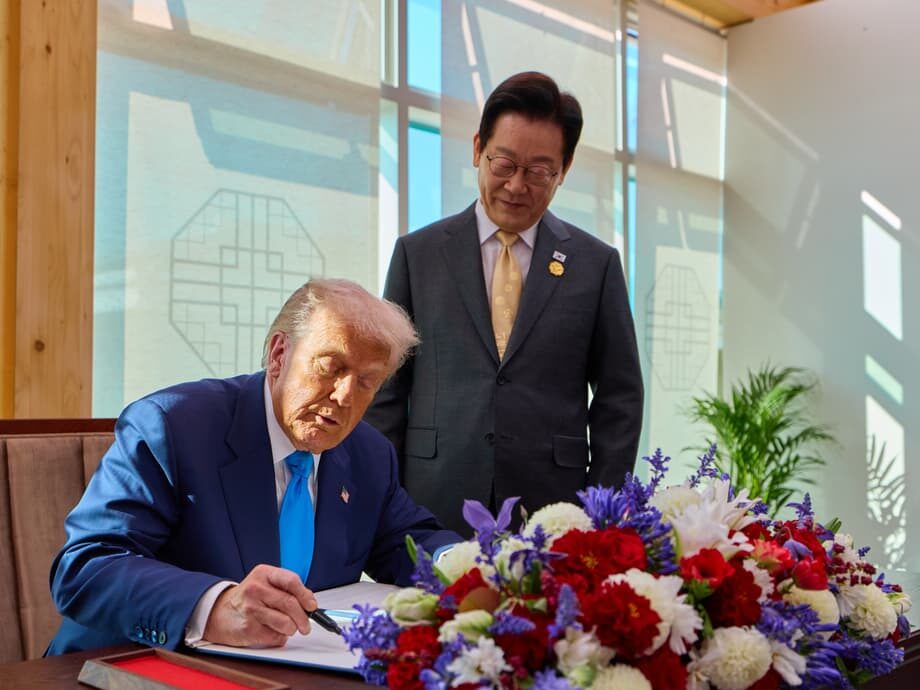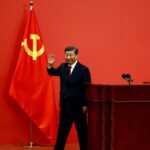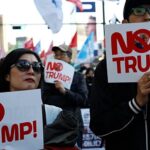Fresh approval puts South Korea on track for nuclear powered submarines
President Donald Trump said he has authorized South Korea to build a nuclear powered submarine, a move that would place Seoul among a small group of nations operating such advanced vessels. The announcement came during a summit with South Korean President Lee Jae Myung in Gyeongju ahead of Asia Pacific Economic Cooperation meetings. Trump also said the boat would be built in Philadelphia, linking the security step to plans to revive shipbuilding jobs in the United States.
- Fresh approval puts South Korea on track for nuclear powered submarines
- What exactly did Washington approve
- Why South Korea wants nuclear powered submarines
- Can Philadelphia actually build this submarine
- Trade, industry and alliance politics behind the announcement
- Nonproliferation, safeguards and regional reactions
- Timeline and what to watch next
- At a Glance
The approval landed alongside a sweeping economic package. South Korea will invest an estimated 350 billion dollars in the United States under a broader trade arrangement, according to official statements in both countries. Of that, about 150 billion dollars is described as support for shipbuilding capacity in American yards. The package also includes purchases of US oil and gas and a reduction in US tariffs on Korean imports to 15 percent from 25 percent. The binding details have not all been released, but the intent is to combine defense cooperation, industrial expansion, and trade relief.
Lee pressed for access to fuel for nuclear propelled submarines and stressed that Seoul is not seeking to arm submarines with nuclear weapons. South Korean officials argue that diesel electric boats have shorter underwater endurance, which limits sustained tracking of North Korean and Chinese submarines in surrounding seas. The backdrop includes heightened tension with Pyongyang, which has strengthened military and economic ties with Russia. Trump said he was unable to arrange a meeting with North Korean leader Kim Jong Un during this visit.
In a series of social media posts, Trump framed the step as a signal of alliance strength and a catalyst for US industry. He wrote on Truth Social:
“Our Military Alliance is stronger than ever before.”
He also touted shipyard jobs and manufacturing, adding:
“Shipbuilding in our Country will soon be making a BIG COMEBACK.”
What exactly did Washington approve
The terms are consequential and also incomplete. The president’s announcement signals political approval for Seoul to pursue a nuclear powered submarine and for work to begin on a construction path in the United States. It does not yet clarify where the naval reactor technology will originate, how fuel will be provided and safeguarded, or how construction in a commercial yard will meet the specialized standards that govern nuclear propulsion for warships. These unanswered pieces will shape the timeline, the cost, and the level of allied coordination required.
South Korea’s Industry Ministry said officials had not been involved in detailed discussions about building a submarine in Philadelphia. The Philadelphia yard is a commercial facility and does not currently handle nuclear material or military shipbuilding. In the United States, only two shipyards, one in Connecticut and one in Virginia, build nuclear submarines for the US Navy today. Those yards operate under rigorous oversight by Naval Reactors, a joint program of the Navy and the Department of Energy that manages every aspect of naval nuclear propulsion safety.
Philadelphia’s yard would need extensive upgrades, dedicated facilities, and years of workforce training to meet the same bar. The announcement is therefore a launch point, not a finished plan. It opens a path, while leaving room for technical, legal, and industrial decisions that will determine whether the program proceeds in Philadelphia, in South Korea, or through a hybrid approach.
Propulsion technology and fuel are the hardest pieces
Naval nuclear propulsion centers on a compact reactor that can power a submarine for long periods without refueling. The United States and the United Kingdom use fuel with very high levels of uranium enrichment for naval reactors. France uses lower enrichment for its boats. Any path that involves US origin nuclear technology or material triggers nonproliferation rules and inspections, and it raises sensitive questions about how to provide fuel while keeping all nuclear material under credible monitoring.
South Korea’s civil nuclear program operates under a bilateral agreement with the US known as a 123 agreement. It restricts enrichment and reprocessing of fuel that comes from US technology or material unless Washington grants consent. Lee asked for a decision that would allow South Korea to receive submarine fuel. He also sought support for progress on reprocessing or enrichment in some form, steps that remain restricted today.
Daryl Kimball, executive director of the Arms Control Association, said the concept requires careful handling. He argued that naval propulsion for an ally “raises all sorts of questions” and highlighted that supplying fuel and technology “would require a very complex new regime of safeguards” by the International Atomic Energy Agency (IAEA), which implements the Treaty on the Non Proliferation of Nuclear Weapons (NPT).
Why South Korea wants nuclear powered submarines
The military case starts under water. A nuclear powered submarine can remain submerged for months, limited more by crew endurance and food than by the need to recharge batteries. It can move faster for longer, and it is harder to detect over time. Diesel electric boats are lethal ambush platforms in coastal waters, and some designs use air independent propulsion systems that extend endurance. Even with these improvements, conventional boats must come up more often, and their sustained open ocean reach is constrained compared with a reactor powered hull.
South Korea has invested heavily in advanced conventional submarines, including its KSS III class, which is large, quiet, and equipped for long patrols. The navy faces a layered challenge. North Korea continues to pursue new undersea capabilities, including efforts to field submarines that can fire ballistic or cruise missiles. China has the world’s largest navy and is increasing the sophistication and range of its submarine force. Seoul sees nuclear powered boats as a way to shadow those fleets over longer ranges and to reduce reliance on US submarines for persistent undersea surveillance.
AUKUS reshaped the debate
The 2021 agreement between Australia, the United Kingdom, and the United States, known as AUKUS, created a path for Australia to acquire nuclear powered submarines with US and UK technology. That decision broke a long standing norm of extreme restraint on sharing naval nuclear propulsion know how beyond the UK. For South Korea, AUKUS showed that a partner could receive such capability within a tight alliance framework that includes heavy safeguards. It raised the prospect of a similar path.
There are important differences. Australia is not seeking domestic enrichment or reprocessing, and the AUKUS plan centers on reactor units supplied under stringent controls. South Korea has asked for broader rights on nuclear fuel cycle activities. That request will draw scrutiny because enrichment and reprocessing expertise can shorten the technical path to weapons if a country later decides to move in that direction, even if the original purpose is naval propulsion.
Can Philadelphia actually build this submarine
Trump said the boat would be built in Philadelphia at a yard now owned by Hanwha, a major South Korean industrial group. The facility, known as Hanwha Philly Shipyard, has built commercial ships like container vessels and tankers. It is not configured today for military work or nuclear propulsion. Converting a commercial yard into a site that can assemble a nuclear powered submarine would require major capital investments, new certifications, security upgrades, and an experienced supply chain.
The US submarine industrial base is already under pressure. Building attack submarines and the new class of ballistic missile submarines has run into worker shortages, supplier bottlenecks, and quality control backlogs. Delivery schedules for Virginia class boats have slipped by roughly two to three years in many cases. The first Columbia class submarine has faced delays of about one and a half to two years. Those same constraints would affect any project that relies on the same pool of skilled trades and critical components.
Adding a new program at a greenfield yard would demand years of workforce recruitment, welding and nuclear quality training, and investment in heavy fabrication halls, clean assembly spaces, and testing facilities. Naval Reactors would need to oversee practices that meet stringent safety standards for reactor compartments and the rest of the boat.
What upgrades would be required
Turning a commercial yard into a facility that can build a nuclear powered submarine would likely require at least the following steps:
- Construction of secure dry docks with the size and strength for submarine modules
- New buildings for reactor compartment assembly and radiological work with strict access control
- Heavy lift cranes, precise alignment gear, and jig fixtures for modular construction
- A certified supplier base for reactor grade piping, valves, pumps, and instrumentation
- Quality assurance systems that meet Navy and Naval Reactors standards, including non destructive testing
- Training pipelines for thousands of welders, pipefitters, electricians, machinists, and inspectors
- Arrangements for spent materials handling and radiological safety that meet federal requirements
Trade, industry and alliance politics behind the announcement
The submarine decision did not arrive alone. It is wrapped inside a package of trade and investment commitments. South Korea plans to invest hundreds of billions of dollars in the United States, with a large slice earmarked for shipyard upgrades. The two sides described an agreement to lower tariffs on Korean goods to 15 percent, while Seoul will import more US oil and gas. The White House and Congress have sought foreign investment to rebuild American shipbuilding capacity, which has eroded over decades in the commercial sector.
Trump has cast the move as a win for American workers and proof of tight alliance coordination. South Korean officials, for their part, frame the investment as a way to deepen industrial links and secure access to critical technology. The balance reflects give and take. Security commitments and access to advanced propulsion on one side, and capital, market access, and energy purchases on the other.
Some experts see a transactional pattern that blends deterrence and commerce. Kim Dong yup, a North Korea studies professor at Kyungnam University, argued that the summit formalized a deal structure that links security guarantees to economic contributions. He warned that the arrangement tilts toward Washington’s interests and could narrow policy flexibility in Seoul. He put it starkly:
“the commercialisation of the alliance and the commodification of peace.”
Nonproliferation, safeguards and regional reactions
China’s foreign ministry urged the United States and South Korea to meet their nuclear nonproliferation obligations. That statement reflects a broader concern. Naval nuclear propulsion involves sensitive materials and knowledge. Under the NPT, non nuclear weapon states can remove nuclear material from safeguards for naval use under strict conditions, but the practice is rare. The IAEA would need to design and verify a tailored approach that keeps all fuel tracked and secure while protecting classified details of submarine design.
South Korea says it is not pursuing nuclear armed submarines. Its goal is to field conventionally armed boats powered by a reactor, which is allowed under the NPT when properly safeguarded. Even so, the fuel cycle questions are not trivial. Fuel for some naval reactors uses high enrichment levels, and any move to grant new rights to enrich or reprocess would reverberate across the region.
Kimball cautioned against opening the door to fuel cycle capabilities that are not required for South Korea’s defense. He said it remains technically and militarily unnecessary for Seoul to acquire capabilities for plutonium separation or uranium enrichment. His argument is that the alliance can meet deterrence needs through other assets, and that a propulsion program should not erode long standing guardrails on sensitive technologies.
Analysts in Washington also note that reports of Russian technical help to North Korea, including claims that Pyongyang seeks a reactor powered submarine, will push Seoul to ask for more. The more these requests expand toward enrichment or reprocessing, the tougher the IAEA safeguards task becomes, and the sharper the debate with Beijing and other regional players.
Timeline and what to watch next
The path from a presidential announcement to a submarine in the water is long and complex. The allies will need a detailed technology transfer framework, including a decision on whether the reactor is supplied as a sealed unit or designed and manufactured with South Korean participation. Naval Reactors would oversee safety and quality for any work done in the United States. A comprehensive safeguards plan with the IAEA would be central, with clarity on fuel supply, accounting, and inspection rights. Congress will likely be consulted on elements that intersect with export controls and security cooperation law, as it was in the case of AUKUS.
South Korean defense officials have said they are developing compact reactors and could build one faster than the decade that such work often requires. Even if the reactor itself is ready earlier, integrating it into a hull, maturing a full combat system, qualifying the crew, and proving out quieting and safety takes years. The United States spent generations refining those processes. A new yard would face a steep learning curve.
The next markers to watch include a formal announcement on the propulsion source, any move by the US to grant consent for fuel related activities under the bilateral nuclear agreement, an industrial roadmap for the Philadelphia yard, and initial milestones for design and workforce training. Each will signal whether this project is set for near term traction or a measured ramp that stretches across the decade.
At a Glance
- Trump said he approved South Korea to build a nuclear powered submarine and named Philadelphia as the build site
- The announcement came with a trade and investment package worth about 350 billion dollars, including 150 billion for US shipyards
- Seoul asked for access to fuel for naval propulsion and stressed it is not seeking nuclear armed submarines
- Technology origin and fuel safeguards remain unresolved, and an IAEA plan would be needed under the NPT
- The Philadelphia yard is a commercial facility and would require major upgrades and training to handle nuclear work
- US submarine builders face delays and supply chain strain that could affect any new program
- Nonproliferation experts warn against granting enrichment or reprocessing rights that are not essential for defense
- Key next steps include decisions on reactor supply, safeguards, industrial upgrades, and workforce timelines




